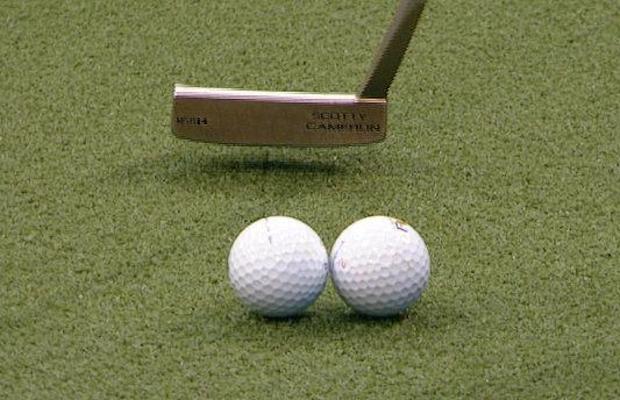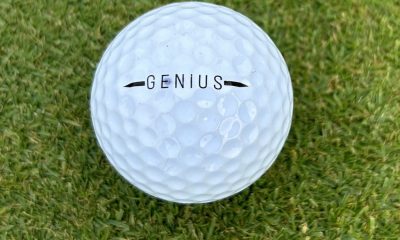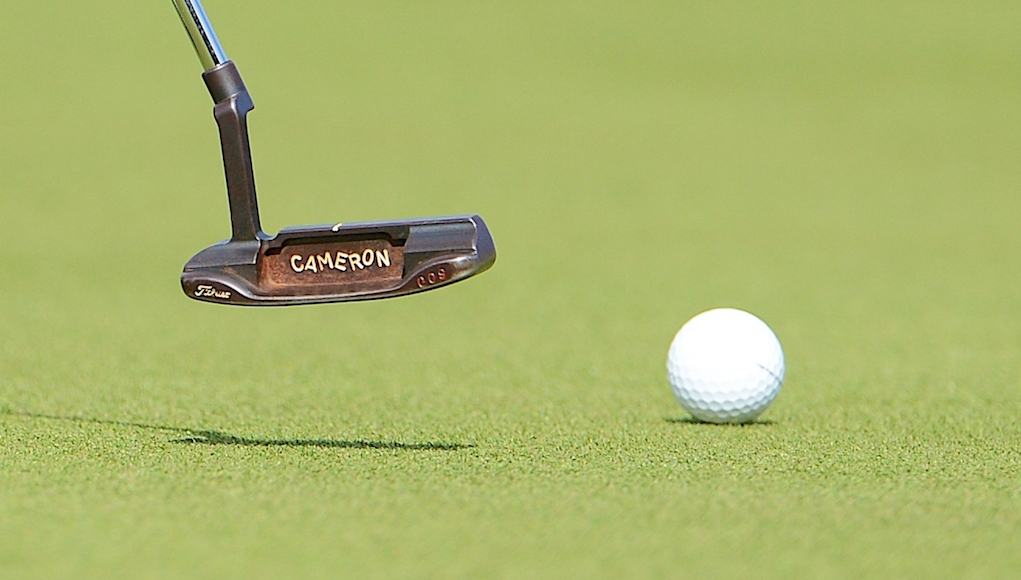Instruction
Rethink how you practice your putting

If you want to make more putts, you should begin by concentrating more on the putter face instead of the path that it travels on.
I see many golfers who work on their putting strokes by trying to perfect their path going back and through. If you are one of those players, you may want to re-think things. Research has shown through SAM Puttlab that putter face alignment is responsible for 83 percent of a putt’s starting direction. With that being said, if the path is only responsible for 17 percent of where the ball starts, why are you spending so much time trying to perfect it?
As a golf coach, I used to spend a lot of time trying to perfect the path that the putter travels during the putting stroke. As technology continues to evolve in our industry, however, we have to adapt to help our players improve their performance. When I found out the face angle is five times more important than the path, I immediately had to rethink how I taught putting.
When looking at the best putters of all time, you’ll find that many have different set-ups, grips, stance widths, tempos, ball positions and paths. The only constant is they all square the putter face to their intended starting line at impact and strike their putts at the same location on the putter face time after time.

Above: Chris DiMarco has won three events on the PGA Tour using a “claw” putting grip.
The great thing about putting and putting well is that there are so many different ways to do it. Putting is an individual art and it should be taught that way. Look at players like Loren Roberts and Brandt Snedeker, for example. If someone got to Loren Roberts at a young age and tried to change his notoriously long and slow stroke, he probably wouldn’t be the great putter that he is today.
Brandt Snedeker is the opposite, as he has a very short and quick stroke, but it’s very effective. Would you teach that to someone? Probably not, but both players are able to consistently square their putter to the intended start line and that is why they are great putters!

Above: Matt Kuchar has used the “Arm Lock” putting style for four of his seven PGA Tour wins.
In order to square the face to the player’s intended start line at impact, I have found that it’s very important to get the player’s face angle at address aligned within about 1-to-2 degrees of their intended start line. This makes for less manipulations during the stroke, which will lead to more consistency and more holed putts, especially from shorter distances.
I like to use a few of the drills below to help golfers improve their face angles when putting. After the drills, I have listed a few troubleshooting tips for anyone having issues with the drills. I would recommend you only pay attention to the troubleshooting area if you find you’re having a tough time, otherwise as I stated above, there are many ways to get the ball in the hole and the below drills can help you begin to hole more putts.
The Ruler Drill
This is one of my favorite drills to help face alignment at address and impact. You will first need to find a ruler. If you don’t have one, I would suggest picking up a metal ruler at your local store. They only cost a few dollars.
Once you have your ruler, you need to align it where the golf ball needs to start. This drill should be used no more than 7 feet from the hole. Place the ball at one side of the ruler, square the face to the ruler at address, make your putting stroke and try to keep the ball rolling down the ruler through its entire length. If you can do this, you have done two things.
- You have squared the face at impact.
- You have most likely struck the ball “square,” allowing it to roll on its intended line.
The Two Ball Drill
This is a great drill to give golfers automatic feedback of what their putter face is doing at the moment of impact. All you need is two golf balls to start.
Place the two golf balls next to each other and make sure they are both flush with the putter face at address. Make a stroke and pay attention to what both golf balls do after impact. If the heel ball takes off first and travels farther, the putter face was open at impact. If the toe ball goes farther, the face was closed at impact. If done correctly, both balls should roll close together and around the same speed. This will show a square face angle at impact.
The Gate Drill
After getting a good feel for the proper face angle at address and impact using the ruler drill and two ball drill, the player can advance to the gate drill. This is a great drill to see how you are progressing after the first two drills.
You’ll see I used two alignment sticks for a good visual, but two tees work just as well. This drill should be started at about 10 feet from the hole and on a straight putt. The player should place the two tees half way between them and the hole. The tees should be about 3-to-4 inches apart.
If the player has good face angles at impact on a solid strike, they will have a great chance of rolling the ball between the two tees and holing the putt. Once the player is successful with the straight putt, they should find a breaking putt and do the same. When working on breaking putts, I suggest that players hit a few putts first to find the apex point. Then place the two tees halfway between you and the hole, and see how well you can do on a breaking putt. As you begin to master this drill, you should move farther back and test how well you can judge line and speed.
Troubleshooting
If you find that you are struggling with any of the above drills, I’d like to suggest a few items that should help. Many times, improper face angle can be caused by a few of the items listed below. Again, only make adjustments if you are consistently struggling with any of the drills.
- Setup: Bend slightly from the ball joints of the hips. Your triceps should rest close to your rib cage, ball position should be slightly forward of your nose, hand position should be between your nose and forward eye and no matter what grip you use, it should run through the lifelines of both hands (with both palms facing each other).
- Lower body stability: Pretend that the lower body is rooted into the ground and cannot move during the stroke. This will help with face angle consistency at impact as well as overall speed control.
- Passive hands: Think about using the bigger muscles only. The torso/shoulders do all the work, and the hands should stay passive and maintain the same angle player started at address. Many problems are created because the trail hand gets overactive, effecting face angle at impact.
Instruction
The Wedge Guy: Beating the yips into submission

There may be no more painful affliction in golf than the “yips” – those uncontrollable and maddening little nervous twitches that prevent you from making a decent stroke on short putts. If you’ve never had them, consider yourself very fortunate (or possibly just very young). But I can assure you that when your most treacherous and feared golf shot is not the 195 yard approach over water with a quartering headwind…not the extra tight fairway with water left and sand right…not the soft bunker shot to a downhill pin with water on the other side…No, when your most feared shot is the remaining 2- 4-foot putt after hitting a great approach, recovery or lag putt, it makes the game almost painful.
And I’ve been fighting the yips (again) for a while now. It’s a recurring nightmare that has haunted me most of my adult life. I even had the yips when I was in my 20s, but I’ve beat them into submission off and on most of my adult life. But just recently, that nasty virus came to life once again. My lag putting has been very good, but when I get over one of those “you should make this” length putts, the entire nervous system seems to go haywire. I make great practice strokes, and then the most pitiful short-stroke or jab at the ball you can imagine. Sheesh.
But I’m a traditionalist, and do not look toward the long putter, belly putter, cross-hand, claw or other variation as the solution. My approach is to beat those damn yips into submission some other way. Here’s what I’m doing that is working pretty well, and I offer it to all of you who might have a similar affliction on the greens.
When you are over a short putt, forget the practice strokes…you want your natural eye-hand coordination to be unhindered by mechanics. Address your putt and take a good look at the hole, and back to the putter to ensure good alignment. Lighten your right hand grip on the putter and make sure that only the fingertips are in contact with the grip, to prevent you from getting to tight.
Then, take a long, long look at the hole to fill your entire mind and senses with the target. When you bring your head/eyes back to the ball, try to make a smooth, immediate move right into your backstroke — not even a second pause — and then let your hands and putter track right back together right back to where you were looking — the HOLE! Seeing the putter make contact with the ball, preferably even the forward edge of the ball – the side near the hole.
For me, this is working, but I am asking all of you to chime in with your own “home remedies” for the most aggravating and senseless of all golf maladies. It never hurts to have more to fall back on!
Instruction
Looking for a good golf instructor? Use this checklist

Over the last couple of decades, golf has become much more science-based. We measure swing speed, smash factor, angle of attack, strokes gained, and many other metrics that can really help golfers improve. But I often wonder if the advancement of golf’s “hard” sciences comes at the expense of the “soft” sciences.
Take, for example, golf instruction. Good golf instruction requires understanding swing mechanics and ball flight. But let’s take that as a given for PGA instructors. The other factors that make an instructor effective can be evaluated by social science, rather than launch monitors.
If you are a recreational golfer looking for a golf instructor, here are my top three points to consider.
1. Cultural mindset
What is “cultural mindset? To social scientists, it means whether a culture of genius or a culture of learning exists. In a golf instruction context, that may mean whether the teacher communicates a message that golf ability is something innate (you either have it or you don’t), or whether golf ability is something that can be learned. You want the latter!
It may sound obvious to suggest that you find a golf instructor who thinks you can improve, but my research suggests that it isn’t a given. In a large sample study of golf instructors, I found that when it came to recreational golfers, there was a wide range of belief systems. Some instructors strongly believed recreational golfers could improve through lessons. while others strongly believed they could not. And those beliefs manifested in the instructor’s feedback given to a student and the culture created for players.
2. Coping and self-modeling can beat role-modeling
Swing analysis technology is often preloaded with swings of PGA and LPGA Tour players. The swings of elite players are intended to be used for comparative purposes with golfers taking lessons. What social science tells us is that for novice and non-expert golfers, comparing swings to tour professionals can have the opposite effect of that intended. If you fit into the novice or non-expert category of golfer, you will learn more and be more motivated to change if you see yourself making a ‘better’ swing (self-modeling) or seeing your swing compared to a similar other (a coping model). Stay away from instructors who want to compare your swing with that of a tour player.
3. Learning theory basics
It is not a sexy selling point, but learning is a process, and that process is incremental – particularly for recreational adult players. Social science helps us understand this element of golf instruction. A good instructor will take learning slowly. He or she will give you just about enough information that challenges you, but is still manageable. The artful instructor will take time to decide what that one or two learning points are before jumping in to make full-scale swing changes. If the instructor moves too fast, you will probably leave the lesson with an arm’s length of swing thoughts and not really know which to focus on.
As an instructor, I develop a priority list of changes I want to make in a player’s technique. We then patiently and gradually work through that list. Beware of instructors who give you more than you can chew.
So if you are in the market for golf instruction, I encourage you to look beyond the X’s and O’s to find the right match!
Instruction
What Lottie Woad’s stunning debut win teaches every golfer

Most pros take months, even years, to win their first tournament. Lottie Woad needed exactly four days.
The 21-year-old from Surrey shot 21-under 267 at Dundonald Links to win the ISPS Handa Women’s Scottish Open by three shots — in her very first event as a professional. She’s only the third player in LPGA history to accomplish this feat, joining Rose Zhang (2023) and Beverly Hanson (1951).
But here’s what caught my attention as a coach: Woad didn’t win through miraculous putting or bombing 300-yard drives. She won through relentless precision and unshakeable composure. After watching her performance unfold, I’m convinced every golfer — from weekend warriors to scratch players — can steal pages from her playbook.
Precision Beats Power (And It’s Not Even Close)
Forget the driving contests. Woad proved that finding greens matters more than finding distance.
What Woad did:
• Hit it straight, hit it solid, give yourself chances
• Aimed for the fat parts of greens instead of chasing pins
• Let her putting do the talking after hitting safe targets
• As she said, “Everyone was chasing me today, and managed to maintain the lead and played really nicely down the stretch and hit a lot of good shots”
Why most golfers mess this up:
• They see a pin tucked behind a bunker and grab one more club to “go right at it”
• Distance becomes more important than accuracy
• They try to be heroic instead of smart
ACTION ITEM: For your next 10 rounds, aim for the center of every green regardless of pin position. Track your greens in regulation and watch your scores drop before your swing changes.
The Putter That Stayed Cool Under Fire
Woad started the final round two shots clear and immediately applied pressure with birdies at the 2nd and 3rd holes. When South Korea’s Hyo Joo Kim mounted a charge and reached 20-under with a birdie at the 14th, Woad didn’t panic.
How she responded to pressure:
• Fired back with consecutive birdies at the 13th and 14th
• Watched Kim stumble with back-to-back bogeys
• Capped it with her fifth birdie of the day at the par-5 18th
• Stayed patient when others pressed, pressed when others cracked
What amateurs do wrong:
• Get conservative when they should be aggressive
• Try to force magic when steady play would win
• Panic when someone else makes a move
ACTION ITEM: Practice your 3-6 foot putts for 15 minutes after every range session. Woad’s putting wasn’t spectacular—it was reliable. Make the putts you should make.
Course Management 101: Play Your Game, Not the Course’s Game
Woad admitted she couldn’t see many scoreboards during the final round, but it didn’t matter. She stuck to her game plan regardless of what others were doing.
Her mental approach:
• Focused on her process, not the competition
• Drew on past pressure situations (Augusta National Women’s Amateur win)
• As she said, “That was the biggest tournament I played in at the time and was kind of my big win. So definitely felt the pressure of it more there, and I felt like all those experiences helped me with this”
Her physical execution:
• 270-yard drives (nothing flashy)
• Methodical iron play
• Steady putting
• Everything effective, nothing spectacular
ACTION ITEM: Create a yardage book for your home course. Know your distances to every pin, every hazard, every landing area. Stick to your plan no matter what your playing partners are doing.
Mental Toughness Isn’t Born, It’s Built
The most impressive part of Woad’s win? She genuinely didn’t expect it: “I definitely wasn’t expecting to win my first event as a pro, but I knew I was playing well, and I was hoping to contend.”
Her winning mindset:
• Didn’t put winning pressure on herself
• Focused on playing well and contending
• Made winning a byproduct of a good process
• Built confidence through recent experiences:
- Won the Women’s Irish Open as an amateur
- Missed a playoff by one shot at the Evian Championship
- Each experience prepared her for the next
What this means for you:
• Stop trying to shoot career rounds every time you tee up
• Focus on executing your pre-shot routine
• Commit to every shot
• Stay present in the moment
ACTION ITEM: Before each round, set process goals instead of score goals. Example: “I will take three practice swings before every shot” or “I will pick a specific target for every shot.” Let your score be the result, not the focus.
The Real Lesson
Woad collected $300,000 for her first professional victory, but the real prize was proving that fundamentals still work at golf’s highest level. She didn’t reinvent the game — she simply executed the basics better than everyone else that week.
The fundamentals that won:
• Hit more fairways
• Find more greens
• Make the putts you should make
• Stay patient under pressure
That’s something every golfer can do, regardless of handicap. Lottie Woad just showed us it’s still the winning formula.
FINAL ACTION ITEM: Pick one of the four action items above and commit to it for the next month. Master one fundamental before moving to the next. That’s how champions are built.
PGA Professional Brendon Elliott is an award-winning coach and golf writer. You can check out his writing work and learn more about him by visiting BEAGOLFER.golf and OneMoreRollGolf.com. Also, check out “The Starter” on RG.org each Monday.
Editor’s note: Brendon shares his nearly 30 years of experience in the game with GolfWRX readers through his ongoing tip series. He looks forward to providing valuable insights and advice to help golfers improve their game. Stay tuned for more Tips!
































Carlo
Jun 3, 2014 at 6:45 am
Hi. I need some drills to help with speed of putts. Any useful drills?
Pingback: Rethink how you practice your putting - I'd Rather Be Golfing
TheCityGame
May 30, 2014 at 8:59 am
I don’t like the “gate drill” on breaking putts. There is more than one line to the hole on a breaking putt. Line can’t be separated from speed on a breaking putt.
That isn’t true of a straight putt.
The only time I’ve really screwed myself up putting is when I got into the mindset that I could hit perfect breaking putts. That if I hit a putt on an EXACT LINE at an EXACT SPEED, it would go into the hole. It takes the ART, and the FEEL out of it.
For that matter, I don’t love it on a straight putt. We already have a technique for determining if we hit a straight putt straight. . .it goes in the hole.
But, I love the idea that you have to be able to roll a putt on your intended line. I just think it can be practiced much more simply. It’s about the only thing an indoor mat is good for, for example.
Bill Schmedes III
May 30, 2014 at 6:01 pm
Thanks for the comments. I agree with some of your comments, it’s just a drill to give face awareness to a player, not sure how it could be much simpler, especially if you go in the order the drills were listed. It’s a progression
The dude
Jun 1, 2014 at 1:36 pm
All putts are straight…….
Jadon
May 29, 2014 at 2:39 pm
I feel like I am a “better than average” putter. I have recently noticed that I’m getting a big hop off the ground off the face of my putter. What am I doing wrong?
Pure
May 29, 2014 at 3:33 pm
You’re hitting down on it too much, may be you have started to move the ball too far back in your stance at address for some reason
Bill Schmedes III
May 29, 2014 at 5:18 pm
I agree with Pure that your hitting down on it too much causing the ball to strike turf and jump up abruptly. Ball position is important but so is the effective loft on your putter. Make sure you don’t have too much forward press effecting loft at impact. I recommend putter fittings to all students as it’s very important to find the correct loft and lie to fit your stroke. This helps produce a true roll.
Drill: Grab three coins and stake them on-top of each other. Address the coins and try to pick the top coin off the pile. This will help improve your rise angle through impact.
Frank Ramsey
Jun 3, 2014 at 12:32 am
Stop looking before you hit the ball and this will avoid the ‘hop off the ground’
Scott
Jun 9, 2014 at 9:53 am
Keep the putter lower to the ground on the take-away….problem solved
Philip
May 29, 2014 at 12:54 pm
Love the exercises – will add them this weekend. Personally I don’t care about my stance when putting, whatever feels relaxed at that moment is what I go with. The result is that I never putted straighter with such great distance control.
Jadon
May 29, 2014 at 4:40 pm
Hm…I try to set up maybe one ball left of center (right handed), I’ll try to move it forward a ball or two and see if that gets it rolling quicker, thanks for the tip
Bill Schmedes III
May 29, 2014 at 5:18 pm
Jadon, see my post above. Hope that helps. Thanks
Jadon
May 30, 2014 at 9:59 am
Bill, I went to the practice putting green and hit about 20 putts yesterday. I adjusted the ball forward in my stance and I’m pretty sure it was working, the greens weren’t great so I couldn’t tell exactly how smooth the ball was coming off the face but it definitely wasn’t jumping. I will work on the coin drill this weekend for sure, I have a competitive round scheduled for Saturday, I’m pumped now, thanks for the drill.
Bill Schmedes III
May 30, 2014 at 5:56 pm
That’s great Jadon. Best of luck Saturday!
Bill Schmedes III
May 29, 2014 at 5:13 pm
Thanks Philip! Let me know how it goes